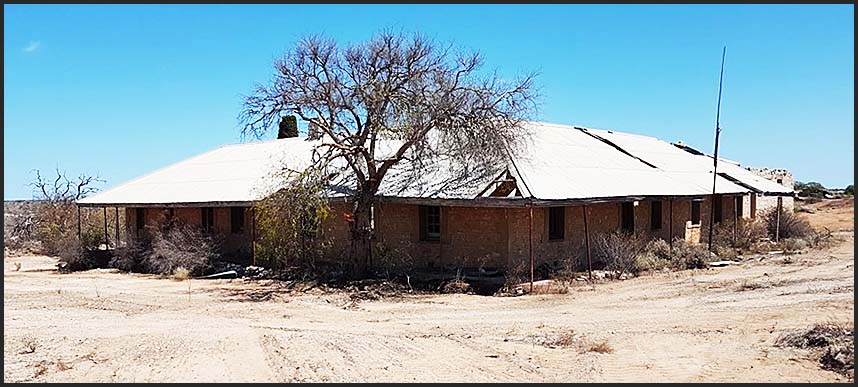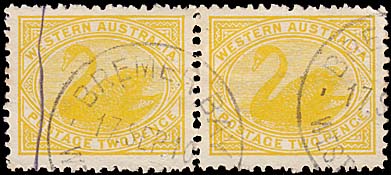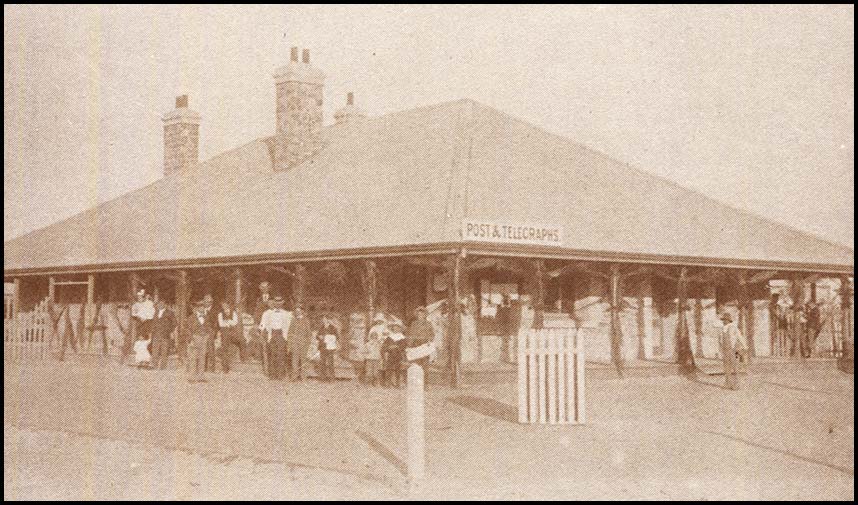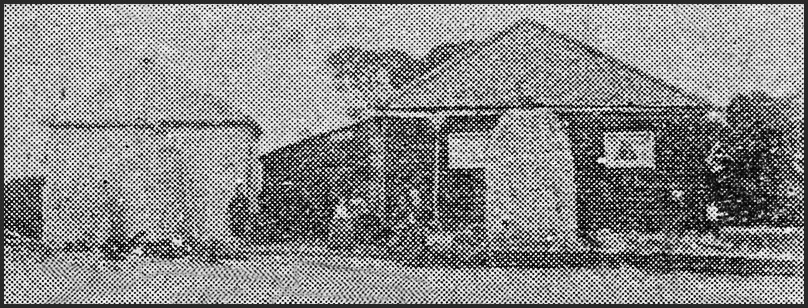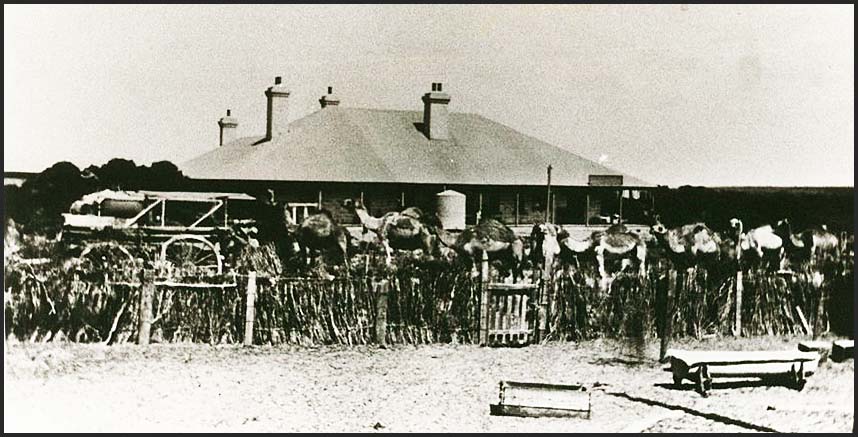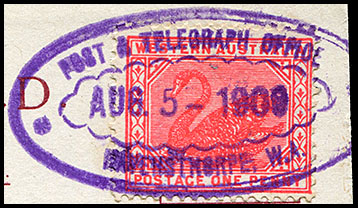Telegraph Offices on the WA to SA inter-colonial line.
- Australia 1901-1988
- New South Wales
- Overview of NSW
- Telegraph lines
- Telegraph Offices
- Date stamps
- Forms
- Envelopes
- Instructional annotation
- Collect
- Delayed
- Free
- Immediate Urgent
- Reply paid
- Rates
- Stamps
- 1871 Telegraph stamps
- 1885 proposal
- 1893 proposal
- Queensland
- South Australia
- Tasmania
- Victoria
- Western Australia
- International
- Special aspects
The Post & Telegraph Offices on the WA-SA Intercolonial lines are listed in the table below:
| Balladonia | Bremer Bay | Esperance Bay | Eucla | |
| Eyre | Israelite Bay | Ravensthorpe |
|
In the broad area above Eucla towards Norseman, various enterprising pastoralists evaluated conditions with a view to establishing properties. One area was identified by the Ponton brothesr and their friend John Sharpe in 1873. Having chosen their land and organised leases, they established a sheep station around the area now referred to as Balladinia. This area was well to the east of Dundas and north of Israelite Bay. It was originally referred to as Ponton's station or just Ponton. As one would, the Ponton brothers became involved in the construction of the first SA - WA telegraph line in 1877 through helping to cart materials and supplies. As progress was made throughout the goldfields, by 1896, the brothers erected a telegraph station on their property on 1896. We do not know about the arrangements for constructing the line. A Telegraph Office was opened at Ponton in December 1896 and it was renamed Balladonia in April 1897. In September 1897, "The block of land for the new Telegraph Station has been fenced with a good substantial stone wall and, some day, permanent premises will be erectcd in place of the present temporary structure" (Esperance Times 8 September 1897). A new Post and Telegraph Office was constructed in 1898: "The new building is a splendid stone-structure with iron roof, containing 6 rooms. The walls are of local stone showing masses of fossils. The stone was secured about half a mile from the site of the building. There has been an abundance of rain at Balladonia during the past three months. There is now an abundance of water in that locality. Not more than a hundred yards off the building is a lake of fresh water about 200yds. wide containing about three feet of water. At Ponton Bros' station there is a dam containing about 17ft. of water. The persons employed on the building are now leaving for Perth. Some of them have been detained at Point Malcolm for about a fortnight owing to the delay in the arrival of a steamer" (Esperance Chronicle 10 Sept. 1898). This Office was upgraded to a Post & Telegraph Office in 1900. |
|
|
|
In December 1897, Executive Council noted that the tender for the construction of the Balladonia Post and Telegraph Office had been let to Mr. W. Harrison for the price of £2,939 9s. Personnel: April 1897: Mr. H. E. Creagh was appointed Telegraph Station Master. In April 1898, the telegraph staff was reduced to the Station Master and one assistant - the rest of the officials being forced to camp out for water at some tanks on the telegraph line 60 miles away. |
|
It is reported that two formats of a rubber oval POST & TELEGRAPH OFFICE date stamp were issued to the office .
|
|
|
|
|
The Telegraph Office was opened as the Esperance Bay Repeater Station on 8 September 1876 (some sources claim 8 August). It had been hoped to have opened the station in April - it was to be the second station to be opened along the line. The first office was a four-room weatherboard building. The first telegram sent from Esperance was by Mr. Charles Edward Demster to his sister Mrs T. C. Gull at Guilford. The township was formally gazetted as Esperance in December 1895. On 21 July 1913, a Coastal Radio Wireless Station was established at Esperance. A Coastal Wireless Station was built from stone on Dempster Head in Orr Street and hence is referred to by the locals as Wireless Hill. The building is still intact and, although apparently not used at present, it is privately owned - hence a good chance for its preservation. |
A new Post and Telegraph Office was constructed in 1895. It was an impressive structure with wide verandahs and was made of stone - as can be seen below. Thankfully as it aged, the intellectualsPerhaps I should add "May God have mercy on their souls!!" although ... in the planning department decided that old things must not be tolerated and so demolished the Office in 1971. The Sydney Morning Herald of 3 December 1895 carried the following article showing the development of Esperance:
But on 22 May 1896, the Western Mail published "Much disgust is expressed at the non-arrival of the Esperance mail. The new arrangements promise to be little better than the old". Esperance declined when it was refused a railway line and, by 1900, most people had left for Ravenswood, Albany or Hopetoun. |
|
Personel. August 1876: Mr. H. G. Stirling was the first Telegraph Officer at Esperance.
1884: Alfred N. Piesse was appointed as a Telegraphist having served at Northam until 1883. August 1894: Mr. James Sinclair was the Post Master at Esperance. His brother Lawrence, together with another brother George and Jack Alsopp had discovered a very rich gold reef at Norseman at that time. Lawrence called the gold find the Hardy Norseman after his horse. was transferred to Roebourne. October 1885: Mr. E. G. Carige, Telegraph Station Master at Esperance Bay was transferred as Telegraph Station Master and Postmaster at Roebourne.
|
|
The Telegraph Office in Eucla was opened on 8 December 1877. It was upgraded to a Post & Telegraph Office in 1895. By 1 January 1896, there were complaints about there being not enough stamps and not enough telegram forms. In April 1896, In January 1897, tenders were called for the erection of a new Telegraph Station at Eucla - with a closing date of 16 March. In November 1897, £7,000 was allocated in the Estimates for the Telegraph Office. A personal account by Mr. F. G. Simmons was published in the Adelaide Mail of 4 August 1945. |
See separate page. |
Personnel: 1882 - 1886: Mr. John Farrant served as Station Master. During his time at Eucla, John married Emily Graham of Eyre. 1885: Alfred N. Piesse was appointed as a Telegraphist having served at Northam until 1883 March 1890: Mr. Michael Ryan was transferred from Eyre to be Assistant and lineman at Eucla to replace Mr. Annear who was transferred to Perth in the same capacity. He had married Clara Graham of Eyre in July 1889. 1895 - 1899: Mr. Michael Ryan as promoted to Telegraph Master. |
|
| An image of the Telegraph Office belongs to the State Library of Western Australia. |
|
The Inquirer of 9 July 1879 reported: "We learn that the natives have lately been troublesome at Eyre Patch, the telegraph station at the east end of Culver Cliffs. Mr. Graham, the Station Master, having missed some sheep, set out in search of them and found them in the hands of natives. The station native, who accompanied Mr. Graham, fired upon the thieves and wounded one fatally". On 29 October 1891, the Daily News reported that "Mr. W. Graham, Telegraph Station Master of Eyre, who is now visiting Perth, has received a telegram from his son stating that splendid rains have recently fallen at Eyre and that the 'Coccle Biddie' shed had been totally destroyed by lightning. Coccle Biddie is a large rock hole on the Nullabor plains, twenty miles north-west of Eyre. This was destroyed in a similar manner about seven years ago. The shed consists of twenty-five sheets of nine-foot galvanised iron. There being no high timber in the neighbourhood is the cause, no doubt, of the mishap to the shed, it being the greatest attraction to the electric fluid". The Western Mail of 22 December 1894 gives an insight into one of life's experiences at Eyre: "In reference to the recent continuous interruption of telegraph communication with the Eastern Colonies, Mr. E Snook, the Superintendent of Telegraphs, has received the following message on Monday from the Stationmaster at Eyre: "The linemen returned last night, both being done up, having been working from 4 a.m. till dark. As every bit of vegetation is destroyed to the water's edge and the seaweed is still burning, they were unable to keep horses or camels near the work but had to carry the poles for miles on their shoulders. They have put in over sixty artificial supports but fear the first gale will blow a lot of them down again. The damage is much greater than was at first supposed. We must have a hundred jarrah poles and two hundred Acne insulators with sockets, pins, screws and binding wire, long handled shovel for digging post holes, a ladder, fodder and water drums as early as possible. Could the Grace Darling come along on her January trip? Promptness is essential to maintain communication. There is no water from here to the 50-mile post. The rain is only 15 miles east of here". In addition - a reflection on isolation and the deprivation of basic life things such as social interaction and receiving mail. From the Captain of the S.S. Wyrallah: "we had a lot of cargo to unload (at Port Malcolm) which detained us until 2.30 p m., when we sailed for Israelite Bay, arriving at 4.30 p.m. Sailed again at 5.30 p.m. ... We arrived at Eyre's Patch at 10.30 a.m. on the 9th. Here a heavy gale prevailed from the S.W. rendering it impossible to communicate with the shore but I managed to get the mail on shore in a barrel which was a great boon to the Graham's to have their mails brought once more. This place is an open roadstead. Sailed for Eucla at 12 p.m. ... we sailed on our return voyage for Eyre's Patch, arriving at 1 p.m. Discharged cargo and sailed again for Israelite Bay at 4 p.m.". There can be no better description of the Eyre Telegraph Station and its situation (or any station for that matter) than that composed by EXILE and printed in the Sunday Times on 25 December 1904: EYRE SAND PATCH.
The Eyre Telegraph Station is listed on the Australian Register of the National Estate. It was restored in 1977 by Birds Australia and is now Australia's first bird observatory. Other stories involving Mr. Graham and his life at Eyre include:
Personnel: |
|
William Graham was born at Newcastle-on-Tyne in 1842, The family soon emigrated to New Zealand and came to South Australia in 1845. He married Emily Trott in 1862. "Mr. Graham arrived in Western Austraia in April 1877 to take charge of one of the repeating stations on the line then under construction which first linked us to the Eastern Colonies and the mother country. He was appointed Station Master at Eyre Sand Patch, an important but isolated post situated 160 miles west of Eucla where he remained "monarch of all he surveys" for the past 21 years. Previous to his entry into this service, Mr. Graham had served under Mr. (now Sir Charles) Todd for many years, holding for a considerable time the important position of Post and Telegraph Master at Kadina, South Australia. He is the oldest telegraphist in Western Australia and one of the oldest in the Colonies having commenced his career as one of Todd's "four boys" who manipulated the needle instruments used in the early days in South Australia and notwithstanding that he is fast approaching his three score years, he is still able to "sit up" to thirty words per minute from our present day "lightning squirters" (Source: Souvenir of the Postal, Telegraph & Telephone Departments of Western Australia, Christmas 1896, p. 63). The family lived at Eyre for 25 years - until 1902. Mr. & Mrs. Graham had six (not seven daughters - some of whom did marry Telegraph Masters. They all possibly did make love through the wires from their remote location, five being married happily and having numerous children, some connected with the Department later on. Five daughters were born while the family lived at Kadina. The Grahams also had at five sons - two were both born in Kadina. William (the father) died at Narrogin in 1912 and Emily died in 1916. |
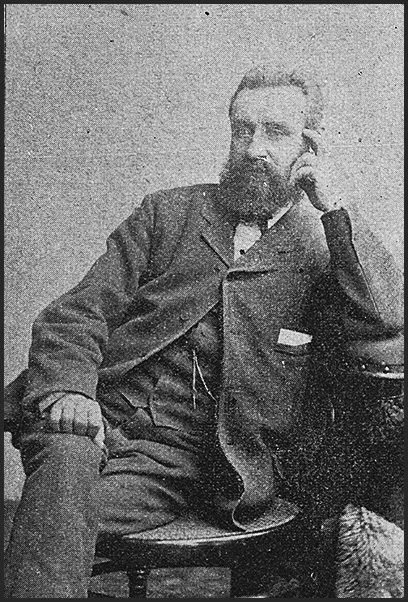 Mr. William Graham, Station Master, Eyre. Source: Souvenir of the Postal, Telegraph & Telephone Departments of Western Australia, Christmas 1896. |
By 1882: Mr. Henry Sutcliff had been appointed Assistant Telegraph Master.March 1890:
October 1885: Mr. J. Brennan was appointed Telegraph Assistant at Eyre.. March 1890: Mr. Michael Ryan was transferred to be Assistant and lineman at Eucla.
Before 1893: Mr. William Lefevre Graham Jnr was appointed Telegraph Assistant. |
|
In May 1900, it was reported that Mr. J. W. W. Graham of Eyre's Sand patch and Mr. H. Foote of Victoria had selected about 2,000 acres near the Williams River. |
|
"Master William Lefevre Graham, second son of Mr. W. Graham, Telegraph Station Master at Eyre, on the Albany- Eucla line, has passed the preliminary University examination at Adelaide and has been transferred to the Roseworthy Agricultural College. Master Graham is a brother of Mrs. John Farrant, of Gooseberry Hill,
near Guildford". Three years later, in February 1896, various newspapers carried the following story: "News has been received here from Adelaide of the success of a young West Australian at the recent examination at Roseworthy Agricultural College, South Australia. The successful student is Mr. William Lefevre Graham, a son of Mr. W Graham, of Eyre's Patch, who has won the Diploma for Agriculture, including ornology and all the compulsory subjects. As an athlete Mr. Graham was also very successful, winning the champion tennis racket, the mile footrace from scratch, the quarter mile from scratch, getting second in the half mile from scratch (the winner having a handicap of a hundred yards), in the hundred yards from scratch and in putting the caber. |
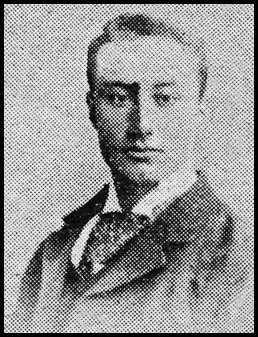 Mr. William Graham Jnr. |
Mr. Graham will now take the vintage course of instruction in one of Mr. Thomas Hardy's well-known large vineyards and cellars, to complete his practical knowledge, which should fit him for a useful career in Western Australia". Further details including his later work at Narrogin as a community leader are included elsewhere. Further detailed information on the Graham Family can be accessed elsewhere. |
|
| Israelite Bay.
The Telegraph Office was opened 5 December 1876. On 27 September 1895 in the Legislative Assembly, the Director of Public Works (Hon. H. W. Venn) referring to item No. 174 (Israelite Bay Telegraph Station, £2,500), said "the proper name for the position of this station would be Point Malcolm and he moved that the words 'Point Malcolm' be inserted in lieu of the words 'Israelite Bay' ". |
||
|
||
Instructions were given in the following month to the surveyors to proceed to Point Malcolm and select a site for the new Post and Telegraph Office and to take a few rough soundings for the jetty. Soon after, on 26 October 1895, the Daily News reported a letter to the Editor: "If rumor be correct the Government is about to perpetrate an egregious blunder relative to the contract for the construction of a new telegraph office at Israelite Bay. The plans and specifications state that the buildings are to be erected at Israelite Bay and accordingly a large amount of timber and other materials have been landed there and the contractor has now been a considerable time on the spot waiting the pleasure of the Government to point out the site. In the meantime, he has raised a quantity of stone and entered into various contracts involving no small expense. But now it is stated that it is proposed to remove the site of the station to Point Malcolm, twelve miles away from Israelite Bay. This will probably mean an extra expenditure of £1,000 to £1,500 on account of the increased difficulties in obtaining building materials and water and extra cartage to Point Malcolm of all the timber, etc, already lying at Israelite Bay. There are however other and stronger reasons why Israelite Bay should be the chosen site. It is very difficult for a stranger to understand why Point Malcolm, except for interested reasons, should be selected in preference to Israelite Bay. The former is, in every way, an inferior site, both as regards water, feed for teams, sites or township, safe harbour and good anchorage for vessels. There is no water nearer than two and a half miles to the landing place at Point Malcolm and, even it becomes bad during continued dry weather whilst at Israelite Bay, there is a plentiful and a never failing supply for man and beast close to the station and landing place and plenty of country and grass for teams. It is true that a document has been signed by a number of persons requesting the site of the new telegraph station to be fixed at Point Malcolm but many of those who signed now see their mistake. Should the Government persist in removing the station to Point Malcolm, it will regret it but once and that will be always. An earlier comment by this newspaper also included "A new and excellent road has just been found leading from here to the cliffs and thence to the goldfields. It is hoped therefore that the Government will not persevere in their attempt to remove the station from here". The Esperance Chronicle of 10 April 1896 noted difficulties with constructing the new Office: "Work at the new Post and Telegraph Station is also at a standstill for want of timber which is still aboard, the contractors being unable to finish roofing till some timber is landed. Cargo is generally thrown down anywhere (by the steamer Macgregor) and owners have to remove it themselves above high water mark or stand a good chance of losing part of it. When we had only communication by the Grace Darling, a sailing craft, we could always rely on cargo being neatly stacked well above high water mark. From Point Malcolm comes the same complaint - she having even passed there without calling for mails". In September 1896, the Israelite Bay station was fitted with the advanced quadruplex instruments by the Chief Electrician of the W.A. Telegraph Department Mr. G. P. Stevens. This work was part of the upgrade of the intercolonial line to South Australia from Albany to Eucla: "On arrival at Albany (June 23) I inspected instruments and batteries there, and, having assured myself that all was in excellent order, proceeded by the s.s. Macgregor to Israelite Bay, where I landed on Sunday, the 27th June. Owing to some slight difficulty between the supervisor and contractor, I could not get possession of the new office at once; but matters were subsequently amicably arranged, and I was enabled to fit up the quadruplex instruments and divert the traffic from old to new office in good time. I am pleased to say that the transfer was effected without causing any delay to business, the new instruments being carefully adjusted and the balances set to positions indicated by the old apparatus were switched into circuit at a pre-arranged signal and work proceeded without interruption. The change of quarters was hailed with delight by the local staff, who had rendered me valuable assistance throughout the work and, within half an hour of the first sound of instruments in new building, the beds, bedding and other personal effects of officers were transferred, each man shouldering his own outfit and taking part in a series of unusual and amusing processions between the two buildings. The trial of quadruplex with Albany and Perth was satisfactory, notwithstanding the fact that the weather was anything but favourable" (West Australian 2 September 1896). |
||
| An excellent You Tube video on Israelite Bay and the Telegraph Office is available. It shows so well (from about 3 mins 5 secs) how strong and sturdy the structure was when it was built about 150 years ago as well as the context of its environment. | ||
Personnel. December 1876: Mr John Paul Brooks was appointed as the first Linesman for the Office. 1885: Alfred N. Piesse was appointed as a Telegraphist having served at Northam until 1883 and from 1884 at Esperance and Eucla. October 1893: Mr. W. Craig was appointed as Assistant at Israelite Bay. |
||
| No special date stamp was issued to the Israelite Bay Telegraph Station for use with telegraph work. Instead the usual postal date stamps (3b) were used from about April 1902. | 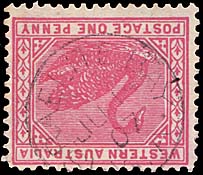 14 June 1907. |
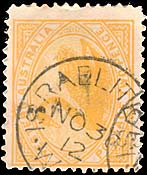 3 November 1912. |
|
The Post & Telegraph Office was opened on 29 January 1901. |
|
A rubber oval POST & TELEGRAPH OFFICE date stamp
|
Abacus December 2019 Lot 2278. |
